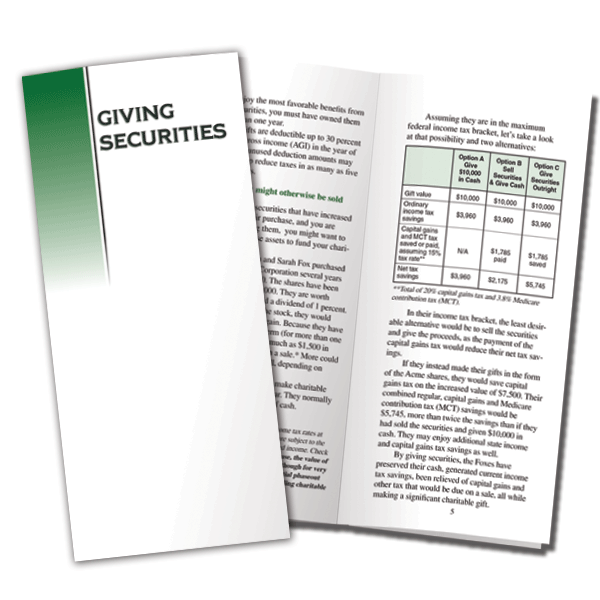Why an emphasis on gifts of securities is important for many fundraising programs.
Gifts of securities have risen along with stock market values in recent years. According to the latest IRS reports, gifts of corporate stock, mutual funds and other investments accounted for more than half of the $60.4 billion reported on form 8283 for tax year 2014 (the latest year for which data is available). $33.2 billion in securities was donated that year. To put this amount in perspective, the total amount of bequest income that year was $31 billion. The average gift of stock was $81,631, while mutual fund donations averaged $66,420.
The overall recovery in charitable giving since 2009 has largely been driven by increases in gifts of corporate stock and mutual funds. There were nearly 400,000 contributions of stock and mutual funds in 2014 alone.
Getting your “share”
Some organizations routinely receive gifts of securities while others rarely, if ever, do. While most charities have policies and procedures in place to accept gifts of securities, they do little to promote or market such gifts. As in the case of bequests, those who proactively ask for these types of gifts are more likely to receive them than those who do not. Imagine the growth that could be possible if even a fraction of the amount of resources devoted to encouraging bequests and other estate gifts were devoted to making donors aware of the advantages of giving securities and other appreciated assets.
Virtually all nonprofits have donors who own these types of assets. They are most likely to be found among middle-aged and older donors who regularly give larger amounts or those making large capital gift commitments.
According to the IRS, 90% of tax returns reporting this type of gift were from individuals 45 and older, and almost 50% were 65 and older. As a result, an age-based strategy may be especially effective when communicating the advantages of such gifts.
A boom in stock gifts?
A combination of economic, demographic and tax factors may be creating an environment today that will result in a surge in gifts of stocks and other investments.
Investment market growth over the past few years combined with volatility in recent months may actually increase interest in gifts of securities as a strategy to create offsetting deductions for recent sales, or to obtain tax-favored payments and tax-free diversification from over-concentrated investments.
Consider that the Dow Jones Industrial Average is up over 2800% since 1981. Household wealth and the number of millionaires are also at record levels. From a demographic standpoint, the population as a whole is getting older. The number of people turning 65 and 70 is expected to grow dramatically as Baby Boomers swell the ranks of those most likely to make gifts of securities.
Additionally, there are important tax motivations that may propel a rise in gifts of securities. In spite of dire predictions about the impact of the new tax act on charitable giving, the benefits of the charitable deduction were actually enhanced in some ways with the increase in the overall Adjusted Gross Income limitations, the elimination of the limit on itemized deductions for higher income taxpayers and the preservation of the full fair market value deduction for gifts of stocks and other capital assets held longer than 12 months.
It is important to note that even those who do not itemize can benefit by making gifts that include appreciation that has never been taxed. That is because any capital gain is bypassed whether or not a donor itemizes the gift. Gifts of certain shares received as part of corporate spinoffs can also help simplify tax reporting and financial paperwork. In the final analysis, however, the bulk of securities gifts will come from the estimated 16 million taxpayers who will continue to itemize their deductions. For these individuals, the charitable deduction may have a much more important role from a tax and financial planning standpoint.
With the elimination or reduction in most other itemized deductions, the charitable deduction now occupies a more vital position in the policies underlying a tax code that is designed to minimize taxes on funds that are voluntarily redirected for charitable purposes. In addition, with the estate tax deduction removed from consideration for all but one-tenth of one percent of estates each year, income tax planning takes on even greater importance for the itemizers who will still provide the bulk of the dollar value of all gifts from individuals.
In addition to outright gifts of appreciated property that can provide up to six years of income tax savings, your donors should consider the possible benefits of funding charitable remainder trusts or gift annuities with highly appreciated, low-yielding stock. Not only will they see potential income tax savings for up to six years, but income in many cases may be taxed at the 0% capital gains tax rate.
The bottom line
If you do not ask the right people for the right types of gifts at the right time in their lives, you will not be as successful as those who do. If you need assistance, Sharpe Group can provide consulting, marketing, training or data services to enhance your program. If you are interested in learning more about gifts of stock, please feel free to review a copy of our booklet “Giving Securities” and learn about other tools by clicking here or contact us at info@SHARPEnet.com or 901.680.5300. ■
Giving Securities
 “Giving Securities” is a 16-page informational booklet designed to inform donors about the benefits of and how to make charitable gifts from appreciated stocks. It addresses gifts of property in general with an emphasis on stocks, bonds, mutual funds and other securities—the most common forms for noncash gifts. Major donors and prospects will appreciate the up-to-date examples of proven benefits when giving securities.
“Giving Securities” is a 16-page informational booklet designed to inform donors about the benefits of and how to make charitable gifts from appreciated stocks. It addresses gifts of property in general with an emphasis on stocks, bonds, mutual funds and other securities—the most common forms for noncash gifts. Major donors and prospects will appreciate the up-to-date examples of proven benefits when giving securities.
These booklets are helpful to use in mailings, at special events, or on donor visits. Sharpe can personalize publications with your contact information and logo on the front and/or back cover. If you prefer something more distinctive to your brand, ask about additional customization options.
To download a preview and to learn about other tools to encourage gifts of securities, click here. ■


